Fraunhofer is working on AI-controlled traffic lights. The intelligent traffic lights should not only ensure a better flow of traffic, but also enable pedestrians to cross the street more safely.
Traveling to and from work can be an ordeal. In stop-and-go mode, the cars roll from one crowded traffic light intersection to the next, especially at peak times, the green wave is a utopia. The Fraunhofer Institute for Optronics, System Technologies and Image Exploitation (IOSB) now wants to tackle this problem with intelligent, predictive traffic lights controlled by artificial intelligence. At the same time, the intelligent traffic light should enable vulnerable people to cross the street more safely thanks to a longer green phase. Fraunhofer has implemented a pilot in the old Hanseatic city of Lemgo.
Current traffic light controls are rule-based, but the rigid rules do not apply to all traffic situations. In addition, the existing sensors – induction loops embedded in the asphalt – only roughly depict the traffic situation. Fraunhofer wants to solve these problems with high-resolution camera and radar sensors that record traffic events more precisely. The number of vehicles waiting at the intersection should be recorded in real time, true to the lane. The average speed of the cars and the waiting time are also recorded.
The real-time sensors are also combined with artificial intelligence, which replaces the rigid control rules. The AI uses deep reinforcement learning algorithms. This machine learning method focuses on finding intelligent solutions to complex control problems. To do this, the Fraunhofer researchers built a realistic simulation model of the Lemgo intersection, where the tests take place, and had the AI train countless iterations in this model. The algorithms trained in this way determine the best traffic light switching behavior and the best phase sequence in order to shorten waiting times at the intersection, reduce driving times and reduce the noise and CO22 pollution caused by traffic jams.
The AI algorithms run on an edge computer in the junction box. This means that the algorithms can also be tested, used and scaled on composite circuits – i.e. used on neighboring traffic lights that are in a composite. Fraunhofer assumes that artificial intelligence could improve traffic flow by 10 to 15 percent.
However, the researchers not only have an eye on the vehicles, but also on pedestrians. With AI support, the pedestrian traffic lights should also be controlled as needed. Particularly vulnerable people such as the elderly or people with disabilities should benefit from this. The aim is to shorten waiting times and increase safety at traffic lights by longer crossing times. According to current studies, the green phases are too short for these groups of people.
The buttons currently installed, mostly small yellow boxes, do not provide any information about the number, age or disability of the passers-by. By implementing AI in combination with high-resolution LiDAR sensors, the process should be automated and the crossing time automatically adjusted and graded according to the needs of the respective pedestrians. Person detection and tracking is achieved on the basis of LiDAR data using AI and implemented in an embedded system in real time. The use of LiDAR sensors instead of cameras has the advantage that pedestrians are displayed as 3D point clouds and therefore cannot be identified, i.e. the data protection requirements are met.



